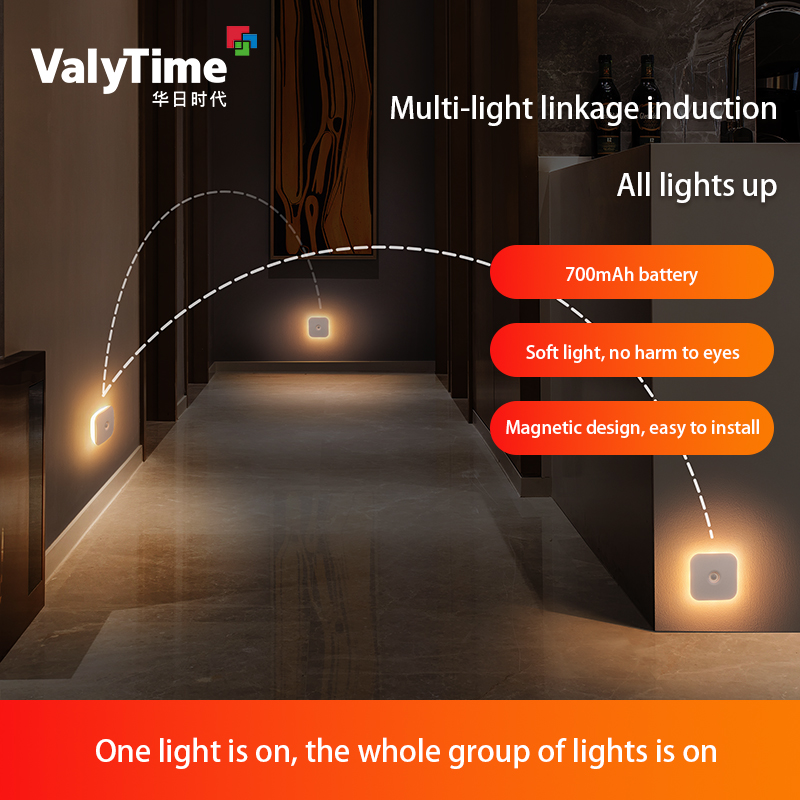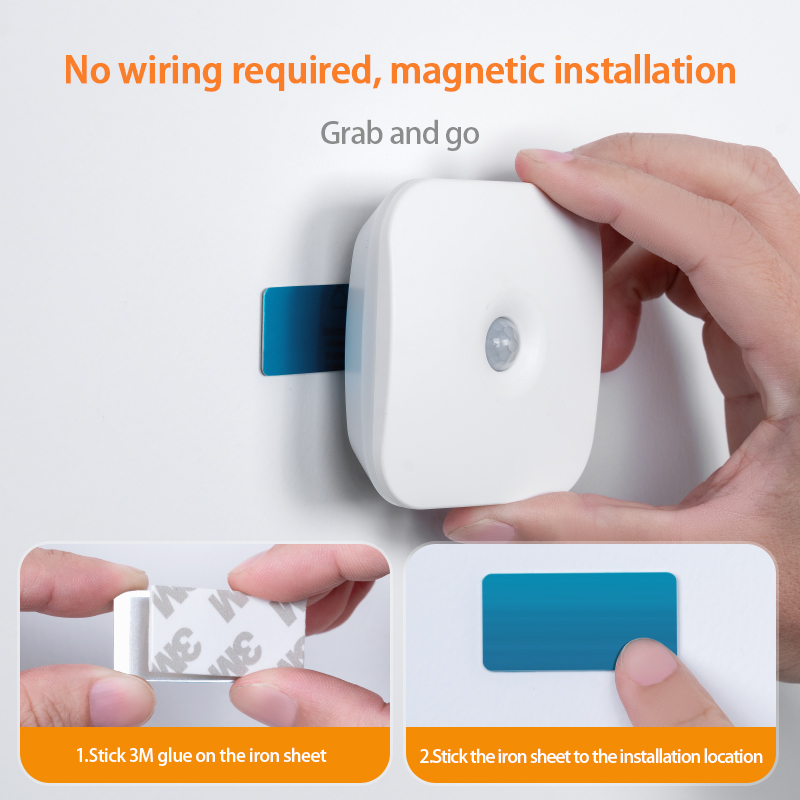How far is the sensing distance of bathroom night light? (0-3 meters)
As smart lighting gradually becomes the trend of modern home lighting, motion sensor bathroom night light has gradually entered thousands of households. As a combination of night lighting and smart technology, this type of lamp is widely used in bathrooms, toilets and other common places at night due to its automatic sensing, low power consumption and high safety.
In the process of purchasing or using, the question "How far is the sensing distance of motion sensor bathroom night light?" is one of the technical parameters that consumers pay most attention to. The sensing distance directly affects the sensitivity, response effect and actual coverage area of the lamp in actual use. Therefore, it is of great value for users to correctly select and reasonably install the motion sensor bathroom night light by deeply understanding the composition principle, measurement standard, influencing factors and the significance of the typical parameter of "0-3 meters" of the sensing distance.
This article will focus on this core issue, from the perspectives of technical principles, product structure, sensing technology categories, influencing factors, user precautions, etc., to comprehensively and professionally analyze the sensing distance characteristics of motion sensor bathroom night light.

What is the principle of motion sensor bathroom night light?
Motion sensor bathroom night light is essentially a smart lamp that integrates sensors and LED lighting systems. Its main structure consists of the following parts:
·PIR infrared sensor module: determines whether there is human activity by passively sensing changes in human infrared radiation.
·Control circuit: After the sensor detects a motion signal, it sends a start signal to the LED lighting module.
·LED lighting component: provides stable and energy-saving lighting.
·Power module: includes built-in batteries, USB charging interface or power adapter to provide power support.
At night or in low-light environments, the sensor continuously monitors human activity in its sensing area. When a human body appears within its sensing range (i.e. 0-3 meters), the sensor converts the sensing signal into an electrical signal, activates the LED light, and automatically lights up the lamp. After leaving the sensing area, the light automatically turns off within the preset delay time.

Motion sensor bathroom night light: Definition of sensing distance "0-3 meters"
The sensing distance of "0-3 meters" means that the motion sensor bathroom night light can accurately sense and activate the light within the human activity distance of up to 3 meters and as close as 0 meters (actually about 20-30 cm). This distance range is measured under standard test conditions (darkness, no obstruction, 25℃ ambient temperature), which is the ideal response distance required by most small and medium-sized household scenes (such as bathrooms and toilets).
·Definition of sensing distance: Starting from the center point of the sensor, within the sensing angle range, the farthest effective straight-line distance that can detect human movement.
Parameter settings under standard conditions usually include:
·Maximum sensing distance: 3 meters
·Minimum effective sensing distance: 20-30 cm
·Sensing angle: about 100-120 degrees (horizontal)
·Applicable space recommendation: closed indoor space less than 10㎡
This setting fully considers the limited space of the bathroom, ensuring that the motion sensor bathroom night light can respond immediately and provide lighting support when going to the toilet, washing hands, entering and leaving the bathroom, etc.

What are the factors that affect the accuracy of the bathroom night light sensing distance?
Although manufacturers usually specify that the sensing distance of motion sensor bathroom night light is "0-3 meters", in actual use, different environmental factors may interfere with and affect the sensing ability, mainly including:
1. Installation height and angle
The installation position of the sensor directly determines its sensing range. Too high or too low installation will cause dead angles, thus affecting the sensing sensitivity. For example, if the lamp is installed too high from the ground, it is difficult for the sensor to cover the close-range motion area, causing response delay.
Suggested installation height of bathroom night light:
·Wall installation: 1.2 to 1.5 meters from the ground is preferred
·Ceiling hanging installation: The downward angle should be kept between 15-30 degrees
2. Ambient temperature
PIR sensors are extremely sensitive to changes in infrared rays released by the human body. However, when the ambient temperature is close to human body temperature (such as the bathroom environment in summer reaching above 35°C), the infrared sensing signal contrast is weakened, and the sensing distance may be reduced to within 1.5-2 meters.
3. Obstructions and glass media
Non-infrared penetrating materials such as glass, shower curtains, and towel racks will block infrared signals, reducing or directly blocking sensing capabilities. If the lamp is facing a mirror or glass surface, reflection interference may also occur.
4. Movement direction and speed
PIR sensors are most sensitive to lateral movement (crossing the sensing area). Forward movement (straight towards the lamp) is slower. The faster the human body moves, the more significant the signal change and the faster the sensing response; if you move slowly in the bathroom or stay stagnant for too long, the trigger may fail.
5. Dust and water vapor
The high humidity environment in the bathroom is prone to water mist or dirt on the sensor surface, affecting infrared transmission, thereby reducing sensing sensitivity. It should be wiped and cleaned regularly to prevent dirt from blocking the sensor window.
How to maximize the effect of bathroom night light sensing distance?
To ensure that the motion sensor bathroom night light achieves the best response effect within the effective range of 0-3 meters, users should pay attention to the following points during installation and use:
1. Choose the installation location reasonably
Install the lamp at the entrance of the bathroom, next to the toilet or in front of the washbasin. These are high-frequency activity areas, which can ensure that it is triggered as soon as you enter.
Avoid installing it behind the door, in the glass shower room, and other places where the signal is easily blocked.
2. Adjust the angle of the lamp
If the bathroom night light allows manual adjustment of the angle, it should be tilted slightly downward to cover the activity area between 0-3 meters on the ground.
3. Regularly maintain the sensor window
Use a dry cloth or alcohol cotton cloth to clean the sensor window to keep its sensing window clear and transparent to avoid reduced sensitivity due to dust.
4. Avoid being close to heat sources
Stay away from heat sources such as heaters and electric water heaters to prevent the infrared contrast signal from decreasing due to excessive ambient temperature.

Analysis of the applicability of the "0-3m" sensing distance of bathroom night light
In actual bathroom usage scenarios, the "0-3m" sensing distance can already meet the needs of most users:
·Small and medium-sized bathrooms (2-6㎡): triggered when entering the door, and lighting covers the entire space.
·Family bathrooms: washing hands, going to the toilet, brushing teeth, etc. are all within the effective sensing range, and there is no need to turn on the headlights at night to avoid affecting sleepiness.
·For children and the elderly: no need to find a switch, it lights up as soon as it is moved, increasing safety.
